Go to about.usps.com/resources/postal-bulletin.htm to browse past issues.
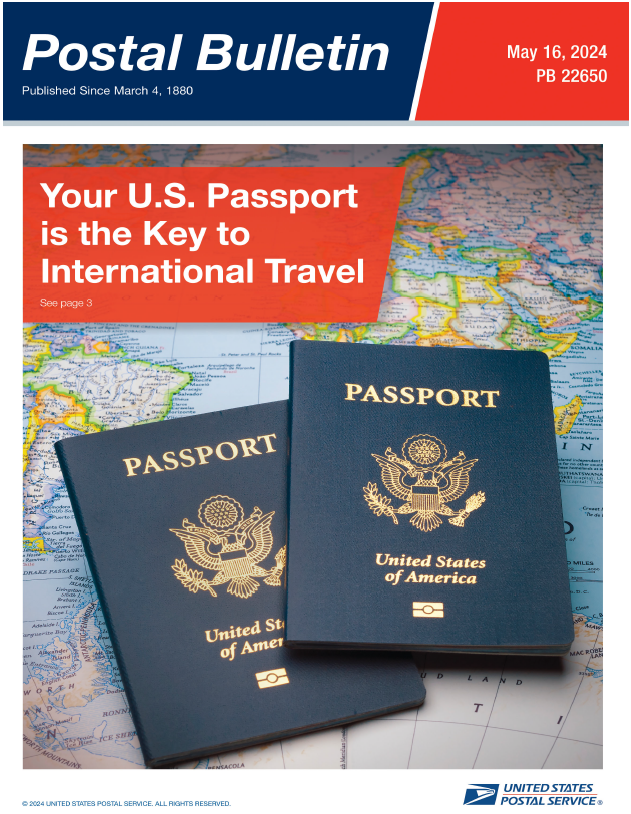
The Postal Service has enabled faster, more efficient communication, created safer, more secure delivery of correspondence and merchandise and has adapted to meet the evolving needs of its customers for 250 years. It’s what we do.
The history of the Postal Service is a large story set on a broad canvas. It is intertwined with the history of America, and it provides a lens from which to observe the evolution of the United States. The postal system strengthened the foundations of our democracy by fostering the flow of ideas and access to America’s free press. It enabled the vast expansion of American industry and commerce, spanning and influencing the rise of the railroads in the 19th century, air travel in the 20th century and the advanced digital technology of recent decades. As America’s economy and society have evolved, so too has the Postal Service to both meet and reflect the nation’s changing needs.
Information about the history of the Postal Service can be found here
BULLETIN
On time. Every time. The Postal Bulletin, a nationally distributed biweekly publication, serves as a source for official policy, procedure updates and departmental news for all Postal Service functions. It has never missed a deadline since its inception in 1880.
Go to about.usps.com/resources/postal-bulletin.htm to browse past issues.

first postage stamps
The first U.S. postage stamps were issued in 1847.
The Post Office Department issued its first postage stamps on July 1, 1847. Previously, letters were taken to a Post Office, where the postmaster would note the postage in the upper right corner. The postage rate was based on the number of sheets in the letter and the distance it would travel. Postage could be paid in advance by the writer, collected from the addressee on delivery, or paid partially in advance and partially upon delivery.
On March 3, 1847, Congress authorized United States postage stamps. The first general issue postage stamps went on sale in New York City, July 1, 1847. One, priced at 5 cents, depicted Benjamin Franklin. The other, a 10-cent stamp, pictured George Washington. Clerks used scissors to cut the stamps from pregummed, nonperforated sheets. Only Franklin and Washington appeared on stamps until 1856, when a 5-cent stamp honoring Thomas Jefferson was issued. A 2-cent Andrew Jackson stamp was added in 1863. George Washington has appeared on more U.S. postage stamps than any other person.
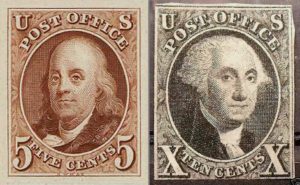
ZIP
Mr. ZIP, who has no first name, appeared in many public service announcements and advertisements urging customers to use their five-digit ZIP Code introduced on July 1, 1963. Within four years of his appearance, eight out of 10 Americans knew who Mr. ZIP was and what he stood for. The character has found new life in recent years a USPS-licensed character and even has YouTube series.
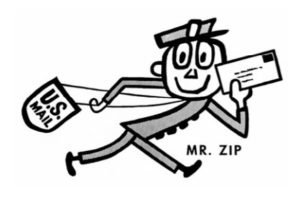
With the introduction of the nine-digit ZIP Code, or ZIP+4, in 1983, Mr. ZIP went into partial retirement. His image still was printed on the selvage of some sheets of stamps, but that practice ended in January 1986. Today, Mr. ZIP is a USPS-licensed character used to expand the Postal Service brand and introduce the organization to new generations of Americans.
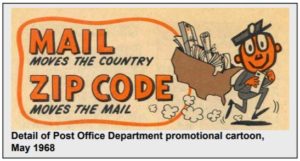
free city delivery
Before 1863, postage paid only for the delivery of mail from Post Office to Post Office. Citizens picked up their mail, although in some cities they could pay an extra two-cent fee for letter delivery or use private delivery firms. An Act of Congress of March 3, 1863, effective July 1, 1863, provided that free city delivery be established at Post Offices where income from local postage was more than sufficient to pay all expenses of the service.
In the late 19th century, free home delivery of mail was introduced — first in cities, then in rural areas — and letter carriers became familiar, trusted visitors to homes and businesses across the country.
Before 1863, postage paid only for the delivery of mail from Post Office to Post Office. Citizens picked up their mail, although in some cities they could pay an extra one- or two-cent fee for letter delivery or use private delivery firms. Among the postal reforms suggested by Postmaster General Montgomery Blair in his 1862 report to the President was free delivery of mail by salaried letter carriers, which he felt would “greatly accelerate deliveries, and promote the public convenience.” He reasoned that if the system of mailing and receiving letters was more convenient, people would use it more often, and pointed to increasing postal revenues in England, which already had adopted free city delivery.
Congress agreed. An Act of Congress of March 3, 1863, effective July 1, 1863, provided that free city delivery be established at Post Offices where income from local postage was more than sufficient to pay all expenses of the service. For the first time, Americans had to put street addresses on their letters.
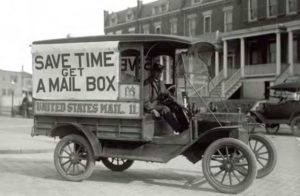
the postal dog
On an autumn day in 1888, a shaggy pup took his first steps toward becoming a postal legend when he crept into the Albany, NY, Post Office. Postal employees allowed him to stay and named him Owney.
At first, Owney stayed close to the Post Office, but he soon began riding mail wagons to the train depot and the railway mail car down to New York City and back to Albany. As Owney traveled farther, his friends at the Albany Post Office feared he might wander too far away to find his way home again, so they purchased a leather collar with a tag reading “Owney, Post Office, Albany, N.Y.” Railway mail clerks recorded Owney’s travels by attaching metal baggage tags to his collar to identify the rail lines he traveled on. He was soon so weighed down by his collection of tags that Postmaster General John Wanamaker presented Owney with a jacket to distribute their weight more evenly.
Owney took to traveling farther and staying away longer, eventually visiting Mexico, Canada, Japan, China, Singapore, Suez, Algiers and the Azores.
One day, while being shown off to an Ohio newspaper reporter, Owney bit the clerk who was handling him. The postmaster had Owney put down on June 11, 1897. Railway mail clerks chipped in money to have a taxidermist preserve Owney’s body, which then was sent to postal headquarters in Washington, DC, for exhibit. In 1911, the Post Office Department entrusted Owney to the Smithsonian Institution. Since 1993, Owney has been on display at the National Postal Museum in Washington, DC. In 2011, Owney was honored on a commemorative U.S. postage stamp.


at Post Offices
Post Offices were first required to display the American flag in 1885 to comply with Treasury Department instructions. As of Nov. 7, 2019, Post Offices are required to fly the Prisoner of War (POW)-Missing in Action (MIA) flag on the same days that the American flag is flown.
In 2024, the Postal Service replaced 28,414 U.S. flags and 34,593 POW-MIA flags.
LINCOLN
On May 7, 1833, 24-year-old Abraham Lincoln was appointed postmaster of New Salem, IL. Lincoln served until the office was closed May 30, 1836.
Two postmasters became U.S. presidents later in their careers — Abraham Lincoln and Harry Truman. Truman held the title and signed papers but immediately turned the position and its pay over to an assistant. Lincoln was the only president who served as a postmaster.
On May 7, 1833, 24-year-old Lincoln was appointed Postmaster of New Salem, IL. Lincoln served until the office was closed May 30, 1836. Postal records show that Lincoln earned $55.70 as postmaster in fiscal year 1835 and $19.48 for one quarter’s work in fiscal year 1837. Besides his pay, Lincoln, as postmaster, could send and receive personal letters free and get one daily newspaper delivered free. Mail arrived once a week. If an addressee did not collect the mail, as was the custom, Lincoln delivered it personally — usually carrying the mail in his hat. Even then, Lincoln was “Honest Abe.”
Reportedly, when the New Salem Post Office was discontinued, Lincoln had a balance of $16 or $18, which he took with him to Springfield, IL. Months later, while his close friend Dr. A. G. Henry was visiting, a Post Office agent called on Lincoln to collect the funds. Henry knew that Lincoln had been in financial straits and feared that he might not have the money. Henry recalled that just as he was about to offer Lincoln a loan, the future president “. . . went over to his trunk at his boarding house, and returned with an old blue sock with a quantity of silver and copper coin tied up in it. Untying the sock, he poured the contents on the table and proceeded to count the coin, which consisted of such silver and copper pieces as the country-people were then in the habit of using in paying postage. On counting it up there was found the exact amount, to a cent, of the draft, and in the identical coin which had been received. He never used, under any circumstances, trust funds.”
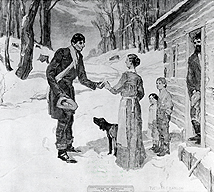
postmasters
Women served as postmasters in this country more than a century before they won the right to vote.
African American postmasters
African Americans worked as postmasters, clerks and carriers beginning in the 1860s — 100 years before the Civil Rights Movement brought about wider opportunity in the American workplace.
An American History
The United States Postal Service has a storied history, familiar to many. Our history is the history of America. Detailed information about the Postal Service and its history can be found in "The United States Postal Service: An American History" at https://about.usps.com/who/profile/history/.
postmaster
The first known female postmaster in the United Colonies was Mary Katharine Goddard in Baltimore in 1775.
female mail carrier
The first known female mail carrier was Sarah Black, who worked as a mail messenger in Charlestown, MD, in 1845.
African American postmaster
The first known African American postmaster was James W. Mason in Sunny Side, AR, in 1867.
African American carrier
The first known African American mail carrier was James B. Christian in Richmond, VA, in 1869.
woman on a stamp
The first American woman on a U.S. postage stamp was Martha Washington in 1902.
American postal inspector
The first known African American postal inspector was Isaac Myers in Baltimore in 1870.
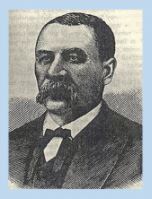
Isaac Myers served as a postal inspector from 1870 until 1879. During his employment he helped solve a number of notorious cases.
American on a stamp
The first Hispanic American on a stamp was U.S. Navy Adm. David Farragut in 1903.
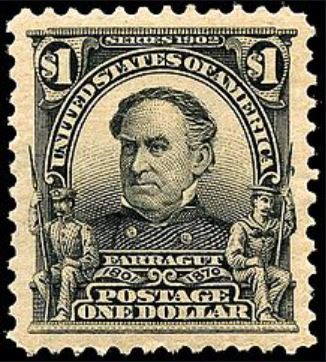
American on a stamp
The first Native American on a stamp was Pocahontas in 1907.
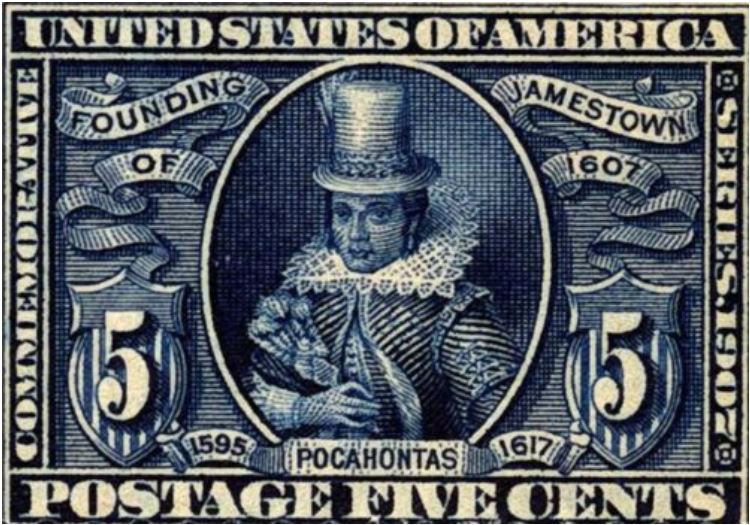
American on a stamp
The first African American on a stamp was educator, author and orator Booker T. Washington in 1940.

postmaster general
The first female postmaster general was Megan J. Brennan, Washington, DC, 2015. Brennan's tenure was Feb. 1, 2015 – June 15, 2020.

first postmaster general
Benjamin Franklin was appointed the first postmaster general by the Continental Congress in 1775.
USPS launches its website
The Postal Service launched its first public website, usps.gov, in 1994. The site became usps.com in 2000.
Visitors to usps.gov are redirected to the official Postal Service website, usps.com.
Headquarters
The U.S. Postal Service Headquarters building is located in Washington, DC, just a few blocks south of the National Mall.
Postal Service Headquarters, 1973 — Present
Vlastimil Koubek designed the present Postal Service Headquarters building, which is located in Washington, DC, just a few blocks south of the National Mall.
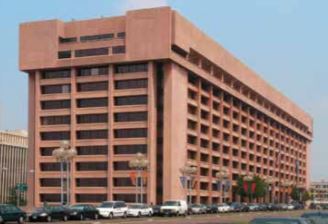
Post Office Department Headquarters, 1899–1934
This granite building on Pennsylvania Avenue, not far from the White House, was the last to simultaneously house both USPS Headquarters and the Washington, DC, Post Office. Horse-drawn wagons brought mail to the building in its early years. By the time the headquarters moved to a larger building, almost all mail was carried by motor vehicles.
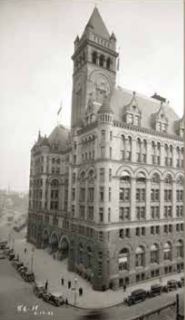
center
Located in Maryland, the William F. Bolger Center is a premier leadership development and conference center servicing both Postal Service and external clients. It is the only hotel in the country featuring an on-site Smithsonian Institution exhibit.
The William F. Bolger Center is a Postal Service-owned, state-of-the-art training facility located on 83 beautiful acres in Potomac, MD. It was built in the 1930’s as a Catholic convent by the Sisters of Mercy.
In the 1980’s, it was purchased by the U.S. Postal Service as a training center.
Named for William F. Bolger (March 13, 1923 – August 21, 1989), the 65th Postmaster General of the United States from March 15, 1978 to January 1, 1985.


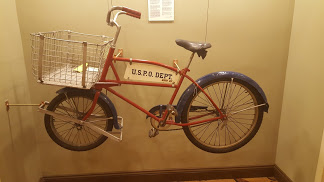

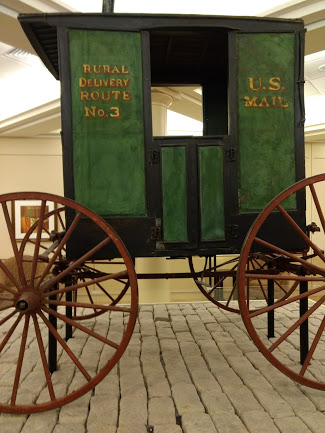

National Postal Museum opens
In 1993, the Smithsonian's National Postal Museum opened. This museum is dedicated to the preservation, study and presentation of postal history and philately.
The Smithsonian’s National Postal Museum offers exhibits tracing the history of the postal system in the United States. It houses millions of postal-related items — mostly stamps, but also postal stationery, greeting cards, covers and letters, mailboxes, postal vehicles, handstamps, metering machines, patent models, uniforms, badges and other objects related to postal history and philately. The museum’s library, with more than 40,000 volumes and manuscripts, is open to the public by appointment. In 2013, the William H. Gross Stamp Gallery — the largest in the world — opened at the museum.
For more information, go to postalmuseum.si.edu.
first Post Office
The first Post Office in America was established in a tavern in Boston in 1639.
and the U.S. Mail
Extra! Extra! American newspapers largely owe their existence to Post Offices. As part of the Post Office Act of 1792, newspapers were permitted to be mailed at extremely low rates. By the start of the 19th century, newspapers made up the bulk of the U.S. Mail.
service men and women
Honoring service members. The Postal Service proudly partners with the U.S. Department of Veterans Affairs to provide burial flags to families of deceased veterans. In 2024, the Postal Service provided 348,285 burial flags.
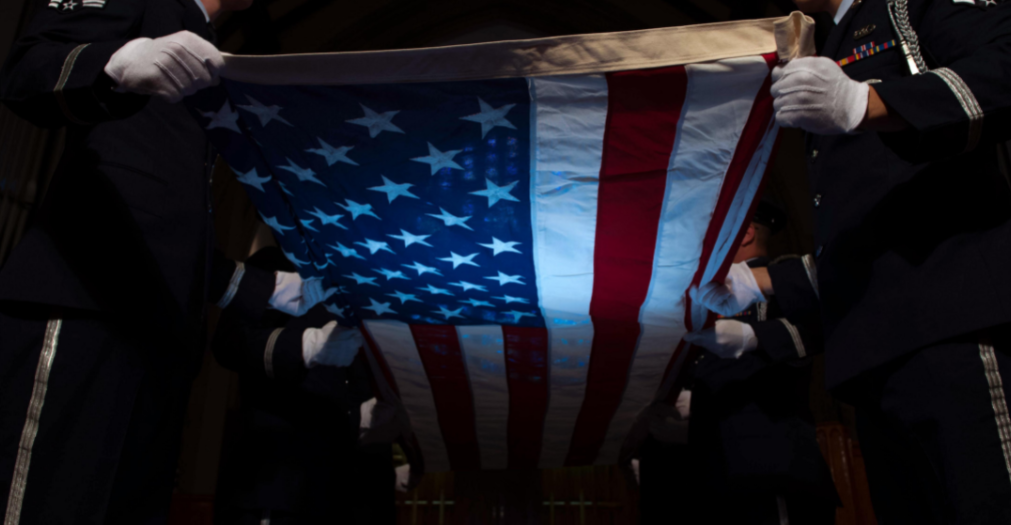
The U.S. Postal Service upholds its promise to deliver the nation’s Election Mail securely and on time, consistent with the organization’s non-partisan public service mission.
Election Mail consists of mail to or from election officials,
including ballots, ballot applications, registration forms
and other items that enable citizens to participate in the voting process. The Postal Service is committed to delivering the nation’s Election Mail securely and on time, consistent with the organization’s nonpartisan public service mission.
During the general election period of Sept. 1-Nov. 15, 2024, the Postal Service delivered at least 99.22 million ballots to or from voters.
The Postal Service supports voters choosing to use the U.S. Mail to return their ballots, whether it’s for a seat on the local school board or for the president of the United States — and everything in between.
Those Who Serve
It’s not just any letter or package. It’s a picture of the kids. It’s a handmade scarf. It’s a favorite candy bar. It’s a pair of socks. It’s a piece of home. The Postal Service helps make sure these very special letters and packages make it to those who serve in the military — and their families with them — wherever they are around the globe.
of USPS
The history of the Postal Service is a large story set on a broad canvas. It is intertwined with the history of America, and it provides a lens from which to observe the evolution of the United States. This story is told beautifully in "The United States Postal Service: An American History" (also known as Pub. 100).
You can find the publication at about.usps.com/publications/pub100.pdf.
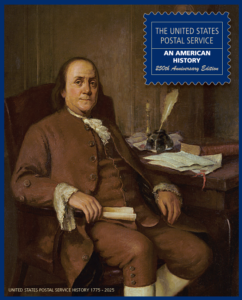
historic buildings
More than 1,400 USPS-owned buildings are listed on the National Register of Historic Places.
Our History is the History of America
Many Postal Service buildings are historical properties. At many Post Office locations, you’ll find impressive works
of art that reflect the stories of our people and our nation.
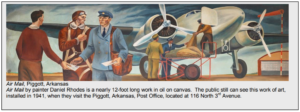
first female inspectors
In 1971, the Postal Inspection Service became one of the first federal law enforcement organizations to hire female agents.
that motto
The U.S. Postal Service has no official motto. Nope, it’s not this phrase: “Neither snow nor rain nor heat nor gloom of night stays these couriers from the swift completion of their appointed rounds.” But we certainly appreciate the sentiment.
About that motto…
Those words are engraved on the front of the James A. Farley Post Office in New York City, set in stone by the architectural firm that built it. The phrase is taken from an ancient book by the Greek historian Herodotus and refers to messengers in the Persian Empire.
The phrase comes from book 8, paragraph 98, of The Persian Wars by Herodotus, a Greek historian. During the wars between the Greeks and Persians (500-449 B.C.), the Persians operated a system of mounted postal couriers who served with great fidelity.
The popular belief that Herodotus’s description of the Persian postal service is about the U.S. Postal Service is a tribute to the hundreds of thousands of men and women who have delivered the mail reliably and dependably, through all conditions, for centuries.
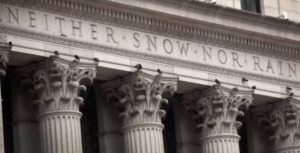
postmaster general
The Postal Service traces its origin to 1775, when Benjamin Franklin was appointed as the first postmaster general of the United Colonies. His annual salary was $1,000. From 1872 to 1971, the postmaster general was a presidential Cabinet member.
Operation Santa
USPS Operation Santa. This program is in its 113th year of operation and relies solely on random acts of kindness and the generosity of strangers. In 2024, millions of people visited uspsoperationsanta.com. Generous customers adopted letters written to Santa and fulfilled wishes, helping families and children experience the magic of the season when they might not have otherwise, one letter to Santa at a time.

For more information, go to USPSOperationSanta.com.
In 2020, the program expanded nationwide for the first time. More than 1 million people visited USPSOperationSanta.com. Generous customers shipped more than 21,000 packages to the families and children who wrote to Santa to help them have a happier holiday.
In 2019, the digital program continued to expand. Letters were accepted letters from 17 locations, and the letters could be adopted by anyone in the country. Gifts could be shipped from more than 19,000 post offices.
In 2018, the Postal Service expanded the 2017 pilot test to include 6 additional cities (Austin, Indianapolis, Philadelphia, Phoenix, San Diego, Washington DC – and Puerto Rico and Chico, CA (site of wildfires). Letters from those locations populated the website and people in those locations only could adopt them and ship from one dedicated post office per city.
In 2017, the Postal Service launched a pilot test of a digital Operation Santa option for residents of New York City. People living in New York City, within proximity of the James A. Farley building could adopt letters online and ship gifts from JAF. Puerto Rico was also added after the hurricanes that year.
HISTORY
In 1912, Postmaster General Frank Hitchcock authorized local postmasters to allow postal employees and citizens to respond to letters addressed to Santa Claus and the program came to be known as Operation Santa.
In the 1940s, mail volume increased to the point where the Post Office Department invited charitable organizations and corporations to participate for philanthropic purposes —providing written responses and small gifts.
Through the years, the program has taken on a life of its own and today cities around the country have established successful programs with recognized charitable organizations, major corporations, local businesses and postal employees making a major difference in the lives of the children from coast to coast.

Trademarks
The Sonic Eagle Logo, the trade dress of USPS packaging, the Letter Carrier Uniform and the Postal Truck and the following marks are among the many trademarks owned by the United States Postal Service: Click-N-Ship®, Deliver The Win®, EDDM®, ePostage®, Every Door Direct Mail®, Express Mail®, First-Class™, First-Class Mail®, First-Class Package International Service®, Forever®, Global Express Guaranteed®, IMb®, Informed Delivery®, Intelligent Mail®, Label Broker™, Parcel Select®, P.O. Box™, Post Office®, Pony Express®, Postal Inspection Service™, PostalOne!®, Postal Police®, #PostalProud®, Priority Mail Express International®, Priority Mail Flat Rate®, Priority Mail International®, Priority: You®, Registered Mail™, Standard Mail®, The Postal Store®, United States Postal Inspection Service®, United States Postal Service®, U.S. Mail®, U.S. Postal Inspector™, U.S. Postal Service®, USPS®, USPS BlueEarth®, USPS Mobile®, USPS Operation Santa®, USPS Tracking®, usps.com®, We are people delivering to people™, ZIP+4® and ZIP Code™. This is not a comprehensive list of all Postal Service trademarks.
Non-Postal Trademarks
Dollar General®, Forest Stewardship Council®, How2Recycle®, McDonald’s®, National Dog Bite Prevention Week®, Starbucks®, Subway®, Sustainable Forestry Initiative®, The Climate Registry®.
Postal Facts 2024 provides the public with information about the U.S. Postal Service. The facts in this publication may be reproduced for the purpose of stating the fact itself, in a business, informational or academic context and the like, and in the body of text discussing factual subject matter relevant to the fact being presented. However, these facts may become outdated after publication and seeking the latest information is advised.
Produced by U.S. Postal Service Corporate Communications
© 2024 United States Postal Service. All rights reserved.
© 2016-2025 United States Postal Service. All rights reserved.
Trademarks
The Sonic Eagle Logo, the trade dress of USPS packaging, the Letter Carrier Uniform and the Postal Truck and the following marks are among the many trademarks owned by the United States Postal Service: Click-N-Ship®, Deliver The Win®, EDDM®, ePostage®, Every Door Direct Mail®, Express Mail®, First-Class™, First-Class Mail®, First-Class Package International Service®, Forever®, Global Express Guaranteed®, IMb®, Informed Delivery®, Intelligent Mail®, Label Broker™, Parcel Select®, P.O. Box™, Post Office®, Pony Express®, Postal Inspection Service™, PostalOne!®, Postal Police®, #PostalProud®, Priority Mail Express International®, Priority Mail Flat Rate®, Priority Mail International®, Priority: You®, Registered Mail™, Standard Mail®, The Postal Store®, United States Postal Inspection Service®, United States Postal Service®, U.S. Mail®, U.S. Postal Inspector™, U.S. Postal Service®, USPS®, USPS BlueEarth®, USPS Mobile®, USPS Operation Santa®, USPS Tracking®, usps.com®, We are people delivering to people™, ZIP+4® and ZIP Code™. This is not a comprehensive list of all Postal Service trademarks.
Non-Postal Trademarks
Dollar General®, Forest Stewardship Council®, How2Recycle®, McDonald’s®, National Dog Bite Prevention Week®, Starbucks®, Subway®, Sustainable Forestry Initiative®, The Climate Registry®.
Postal Facts 2024 provides the public with information about the U.S. Postal Service. The facts in this publication may be reproduced for the purpose of stating the fact itself, in a business, informational or academic context and the like, and in the body of text discussing factual subject matter relevant to the fact being presented. However, these facts may become outdated after publication and seeking the latest information is advised.
Produced by U.S. Postal Service Corporate Communications
© 2024 United States Postal Service. All rights reserved.
© 2016-2025 United States Postal Service. All rights reserved.